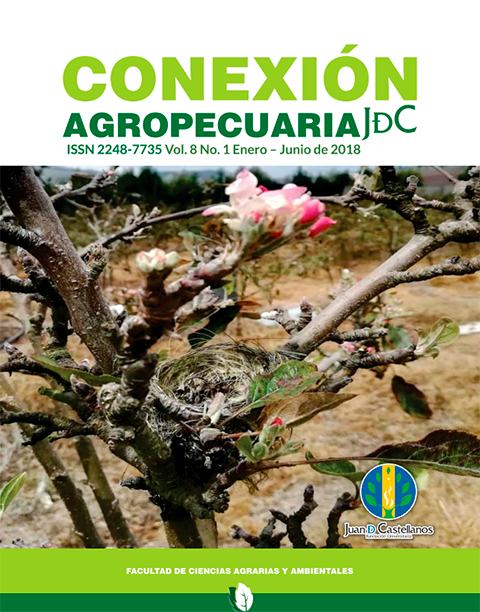DOI:
https://doi.org/10.38017/22487735.616Palavras-chave:
atopia, colágeno, estrato corneano, hipersensibilidade tipo I, hipersensibilidade tipo IVResumo
Dermatite são patologias frequentes na consulta de pequenos animais, sendo uma condição inespecífica que ameaça o bem-estar de cães e felinos e afeta a dinâmica da família desses indivíduos. Dentro do grupo de dermatite, o atópico tornou-se uma condição difícil de diagnóstico e tratamento. Sabe-se que a dermatite atópica canina (ACD) é multifatorial e depende da predisposição genética de indivíduos e estímulos ambientais, que podem ser afetados pelas mudanças climáticas. A resposta imune complexa nos caninos nos permitiu entender a dermatite atópica humana, tornando-se um modelo médico para pesquisa. Essa inflamação alérgica é mediada por uma resposta de hipersensibilidade tipo I ou IV, sendo semelhante em cães e humanos. Os mastócitos, células com presença importante na pele canina, facilitam o recrutamento de leucócitos, favorecem a adesão e a diapedese dessas células, permitindo que a resposta inflamatória seja exagerada. Nas citosinas de resposta imune, fator de necrose tumoral, natural killer, entre outros, que facilitam a comunicação entre a imunologia inata e adquirida, levando à resposta imune complexa e permitindo que a resposta imune-mediada ocorra. Além disso, a partir da resposta imune individual, o DCA pode ser complicado pela contaminação secundária de microrganismos, que levam a suas próprias respostas imunes, dependendo de sua natureza. Este documento pretende expor da conformação anatômica da pele e de sua resposta imune a apresentação da DCA.
Downloads
Referências
Ackerman, B. Schotland, E., Tamayo, M. y Martin-Reay, D. (2001). The infundibulum is epidermal, not follicular. Dermatopathology: Practice & Concept, 7, 396-398.
Akdis, C., Akdis, M., Bieber, T., Bindsley, J., Sen, C., Boguniewicz, M. y Eigenmann, P. (2016). Diagnosis and treatments of atopic dermatitis in children and adults: European Academy of Allergology and Clinical Immnulogy. Journal Allergy Clinical Immnunology, 118, 152-169
Almela Sánchez, R. M. (2014). Dermatología clínica en perros y gatos. Andalucia, España. IC editorial. (No. 636.708965076 A4D4).
Banks, W.J. (1993). Applied veterinary histology. 3 ed. Texas: Mosby Year Book. Inc.
Belkaid, Y. y Segre, J. A. (2014). Dialogue between skin microbiota and immunity. Science, 346, 954-959
Berker, M., et al C. (2017). Allergies–AT cells perspective in the era beyond the TH1/TH2 paradigm. Clinical Immunology, 174, 73-83.
Bradley, C., Morris, D. y Rankin, S. (2016). Longitudinal evaluation of the skin microbiome and association with microenviroment and treatment in canine atopic dermatitis. Journal Investigation Dermatology, 136, 1182-1190.
Broide, D. y Sriramanao, P. (1998). Inhibition of eosinophil rolling and recruitment in P-selectin-and ICAM-1-deficient mice. Blood, 91, 2847-2856
Castellanos, G., Rodríguez, G. E Iregui, C. (2005). Estructura histológica normal de la piel del perro (estado del arte). Revista de Medicina Veterinaria, 10,109-122
Castrillón, E. L., Ramos, A. P. y Padilla Desgarennes, C. (2008). The immune function of skin. Dermatología Revista Mexicana, 52(5), 211-224.
Chaudhary, S., et al. (2019). Alterations in circulating concentrations of IL-17, IL-31 and total IgE in dogs with atopic dermatitis. Veterinary dermatology, 5(30), 383-e114
Chénier, S. Y Doré, M. (1998). P-selectin expression in canine cutaneous inflammatory disease and mast cell tumors. Veternarian pathology, 35, 85-93
Chermprapai, S. (2019). The Immune-pathogenesis of Canine Atopic Dermatitis: Skin barrier, Microbiome and Inflammation (Doctoral dissertation, Utrecht University).
Christofidou-Solomidou, M., Murphy, J. y Albelda, S. (1996). Induction of E-selectin dependent leukocyte recruitment by mast cell degranulation in human skin grafts transplanted on SCID mice. American Journal Pathology, 148, 177-188
Dellmann, D. (1993). Histología veterinaria. 2º ed. Zaragoza: Acribia.
De Mora, F., García, G., Puigdemont, A., Arboix, M., y Ferrer, L. (1996). Skin mast cell releasability in dogs with atopic dermatitis. Inflammation research, 45(8), 424-427.
De Vinney, R. y Gold, W. (1990). Establishment of two dog mastocytoma cell lines in continuous culture. American Journal Respir Cell Molecular Biology, 3, 413-420
Di Cesare, A., Di Meglio, P. y Nestle, F. (2008). A role for Th17 cells in the immunopathogenesis of atopic dermatitis? Journal of investigative Dermatology, 128(11), 2569-2571
Ellis, C., Luger, T., Abeck, D., Allen, R., Graham, R., y De Prost, Y. (2003). International consensus conference on atopic dermatitis II (ICCAD II): clinical update and current treatment strategies. Br. Journal dermatology, 148, 3-10
Emery, D. L., Djokic, T. D., Graf, P. D. y Nadel, J. A. (1989). Prostaglandin D2 causes accumulation of eosinophils in the lumen of the dog trachea. Journal of Applied Physiology, 67(3), 959-962.
Flohr, C., Johansson, Sgo., Wahlgren, C. F. y Williams, H. (2015). How atopic is atopic dermatitis? J Allergy Clin Immunology, 114,150–158.
Fogel, F. y Manzuc, P. (2009). Dermatología canina para la práctica clínica diaria. Buenos Aires, Argentina. Intermedica
Foster, A. y Foil, C. (2012). Manual de dermatología de pequeños animales y exóticos. Segunda edición. España. Lexus.
Ganz, T. (2003). Ther role of antimicrobial peptides in innate immunity. Integral Component Biology, 43, 300-304
Hammerberg, B., Olivry, T. y Orton, S. (2001). Skin mast cell histamine release following stem cell factor and high-affinity immunoglobulin E receptor cross-linking in dogs with atopic dermatitis. Veterinary Dermatology, 12, 339-346
Hanifin, J., Cooper, K. Ho, V., Kang, S., Krafchik, B. y Margolis, D. (2004). Guidelines of care for atopic dermatitis. Journal American Academic Dermatology, 50, 391-404
Hogaboam, C., et al. W. (1998). Novel role of transmembrane SCF for mast cell activation and eotaxin production in mast cell-fibroblast interactions. The Journal of Immunology, 160(12), 6166-6171.
Jung, K., Linse, F., Pals, S. T., Heler, R., Moths, C., y Neumann, C. (1997). Adhesion molecules in atopic dermatitis: patch tests elicited by house dust mite. Contact dermatitis, 37(4), 163-172.
Junghans, V., Gutgesell, C., Jung, T. y Neumann, C. (1998). Epidermal cytokines IL-1β, TNF-α, and IL-12 in patients with atopic dermatitis: response to application of house dust mite antigens. Journal of investigative dermatology, 111(6), 1184-1188.
Lenormand, C. y Lipsker, D. (2018). Mosaicismo. EMC- Dermatología, 52(2): 1-11
Lloyd, D. y Patel, A. (2008). Estructura y funciones de la piel. En: Manual de dermatología en pequeños animales y exóticos. Foster, A., Foil, P., Alhaidari, Z., Bensignor, E., Burrows, M., Byrne, K. y Ferguson, A. (eds.). 2º edición. Barcelona, España.
Maeda, S., et al, (2002). Expression of CC chemokine receptor 4 (CCR4) mRNA in canine atopic skin lesion. Veterinary immunology and immunopathology, 90(3-4), 145-154
Marsella, R. (2013). Fixing the skin barrier: past, present and future--man and dog compared. Vet. Dermatol, 24, 73- 6.e17-8
Matsuoka, T., et al. (2000). Prostaglandin D2 as a mediator of allergic asthma. Science, 287(5460), 2013-2017.
Miller, W., Griffin, C., y Campbell, K. (2014). Dermatología: en pequeños animales. 7º ed. Volumen 1. Buenos Aires, Argentina: Intermedica.
Monteiro, N., Stinson, A. y Calhoun, L. (1993). Integumento. En: Histología veterinaria. Delmann, D. (ed.) 2º edición. Zaragoza: Acribia, 323-352
Nahm, D., Lee, E., Park, H., Kim, H., Choi, G. y Jeon, S. (2008). Treatment of atopic dermatitis whit a combination of allergen-specific immunotherapy and a histamine-immunoglobulin complex. International Archives of Allergy and Immunology, 146(3), 235-240
Nakatani, T.,et al. (2001). CCR4+ memory CD4+ T lymphocytes are increased in peripheral blood and lesional skin from patients with atopic dermatitis. Journal of Allergy and Clinical Immunology, 107(2), 353-358.
Nesbitt, G. y Ackerman, L. (2001). Dermatología canina y felina: diagnóstico y tratamiento. Buenos Aires: Intermédica.
Novak, N. y Leung, D. Y. (2010). Pediatric Allergy: Principles and Practice (Eds Leung, D.Y. & Sampson, H.) W.B. Saunders, Edinburgh, 552-563
Nuttall, T. J., Knight, P. A., Mcaleese, S. M., Lamb, J. R. y Hill, P. B. (2002). Expression of Th1, Th2 and immunosuppressive cytokine gene transcripts in canine atopic dermatitis. Clinical & Experimental Allergy, 32(5), 789-795.
Nuttall, T., Marsella, R., Rosenbaum, M., Gonzales, A. y Fadok, V. (2019). Update on pathogenesis, diagnosis, and treatment of atopic dermatitis in dogs. JAVMA, 254(11), 1291-1300.
Olivry, T. (2012). What can dogs bring to atopic dermatitis research. En Ring, J., Darsow, U., Behrendt, H. (Eds.). New trends in allergy and atopic eczema. Chem Immnulogy Allergy.
Olivry, T., Naydan, D. y Moore, P. (1997). Characterization of the cutaneous inflammatory infiltrate in canine atopic dermatitis. American Journal Dermatopathology, 19, 477-486
Ortega-Velazquez, R., et al. (2004). Collagen I upregulate extracellular matrix gene expression and secretion of TGF-β1 by cultured human mesangial cells. American Journal of Physiology-Cell Physiology, 286(6), C1335-C1343.
Oyoshi, M. K., He, R., Kumar, L., Yoon, J. y Geha, R. S. (2009). Cellular and molecular mechanisms in atopic dermatitis. Adv. Immunology, 102, 135-226
Paterson, S. (2009). Manual de enfermedades de la piel en perros y gatos. Segunda edición. Buenos Aires. Argentina: Intermedica.
Pierezan, F., Olivry, T. y Paps, J. (2016). The skin microbiome in allergen-induced canine atopic dermatitis. Veterinary Dermatology, 27, 332-339
Roque, J., O´Leary, C. y Kyaw-Tanner, M. (2011). PTPN22 polymorphisms may indicate a role for this gene in atopic dermatitis in West Highland White Terriers. BCM Res Notes, 4, 571-577
Santoro, D., Marsella, R. y Pucheu-Haston, C. (2015). Review: pathogenesis of canine atopic dermatitis: skin barrier and host-microorganism interaction. Veterinary Dermatology, 26, 84-94
Scott, D., Miller, W. y Griffin, C. (2001). Small animal dermatology. Saunders 6º ed. Philadelphia.
Silvestri, M., Spallarossa, D., Battistini, E., Sabatini, F., Pecora, S., Parmiani, S. y Rossi, G. (2002). Changes in inflammatory and clinical parameters and in bronchial hyperreactivity asthmatic children sensitized to house dust mites following sublingual immunotherapy. Journal of investigational allergology & clinical immunology, 12(1), 52-59.
Simou, C., Thoday, K. y Forsythe, P. (2005). Adherence of Staphylococcus intemedious to corneocytes of healthy and atopic dogs: effect of pyoderma, pruritus score, treatment and gender. Veterinary Dermatology, 16, 385- 391
Sinke, J., Thepen, T., Bihari, I., Rutten, V. y Willemse, T. (1997). Immunophenotyping of skin-infiltrating T-cell subsets in dogs with atopic dermatitis. Veterinary immunology and immunopathology, 57(1-2), 13-23
Springer, T. 1994. Traffic signals for lymphocyte recirculation and leukocyte emigration: the multistep paradigm. Cell, 76, 301-314
Teran, L. 2000. CCL chemokines and ashtma. Immunology Today, 21, 235-241
Torres, R. (2003). Expresión de moléculas proinflamatorias en modelos caninos de inflamación alérgica in vivo e in vitro. Tesis doctoral. Universitat Autónoma de Barcelona. 108pp
Toru, H., Ra, C., Yata, J. y Nakanata, T. (1998). Human mast cells produce IL-13 by high-affinity IgE receptor cross-linking: enhanced IL-13 production by IL-4-primed human mast cells. Journal Allergy Clinical Immunology, 102, 491-502
Tupker, R. A., De Monchy, J. G., Coenraads, P. J., Homanb, A., y Van Der Meer, J. B. (1996). Induction of atopic dermatitis by inhalation of house dust mite. Journal of allergy and clinical immunology, 97(5), 1064-1070.
Virga, V. (2003). Behavioral dermatology. The Veterinary clinics of North America. Small animal practice, 33(2), 231-51.
Wardlaw, A. J. (2001). Eosinophil trafficking in asthma. Clinical Medicine, 1(3), 214-218
Weese, J. (2013). The canine and feline skin micribiome in health and disease. Veterinary Dermatology, 24, 137-145
Wershil, B. K., Wang, Z. S., Gordon, J. R. y Galli, S. J. (1991). Recruitment of neutrophils during IgE-dependent cutaneous late phase reactions in the mouse is mast cell-dependent. Partial inhibition of the reaction with antiserum against tumor necrosis factor-alpha. The Journal of clinical investigation, 87(2), 446-453.
Wilhem, S., Kovalik, M. y Favrot, C. (2011). Breed-associated phenotypes in canine atopic dermatitis. Vet Dermatol, 22, 143-149
Woltman, G., Mcnulty, C. y Dewson, G. (2000). IL-3 induces PSGL-1/P-selectine-dependent adhesion of eosinophils, but no neutrophils, to HUVEC under flow. Blood, 95, 3146-3152
Wood, S., Ke, X., Nuttall, T. (2009). Genome-wide association analysis of canine atopic dermatitis and identification of disease related snps. Immunogenetics, 61, 765-772
Yager, J. y Scott, D. (1993). The skin and appendages. En: Pathology of domestic animals. Jubb, K., Kennedy, P. y Palmer, N. (Eds.). Academic Press 4ª ed., San Diego.
Yano, K., Yamaguchi, M., Lantz, C, Butterfield, J., Costa, J. y Galli, S. J. (1997). Production of macrophage inflammatory protein-1alpha by human mast cells: increased anti-IgE-dependent secretion after IgE-dependent enhancement of mast cell IgE-binding ability. Laboratory investigation; a journal of technical methods and pathology, 77(2), 185-193.
Zimmerman, G., Mcintyre, T., Mehra, M. y Prescott, S. (1990). Endothelial cell-associated platelet-activating factor: a novel mechanism for signaling intercellular adhesion. The Journal of Cell Biology, 110(2), 529-540.





